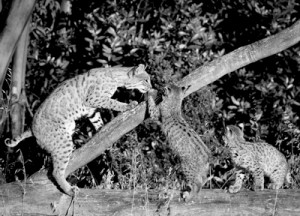UCLA grad student fights to save local bobcats
Rat poison, ingested secondhand, threatens already dwindling population
Source of this article: The Thousand Oaks Acorn, August 30, 2012
A doctorate student at UCLA is asking Ventura County homeowners to think twice before using rat poison.
Laurel Serieys is in the midst of a six-year research project that’s revealing how the toxic substance is affecting the area’s already dwindling bobcat population.
Since 2006, the 32-yearold has caught and released roughly 60 of the furry felines— many in the Santa Monica Mountains— as part of a study to determine the effect urban development is having on the health of the animals, which now number around 300 in the Greater Los Angeles area.
“It’s cumbersome, time-intensive and requires a lot of patience,” said Serieys, who is pursuing a doctorate degree in ecology and evolutionary biology. “I’ve caught foxes, raccoons, coyotes, predatory birds, possums, domestic cats, skunks. . . . It’s super exciting when I actually catch a bobcat.”
Part of her research focuses on the use of rat poison, which, when ingested by the large cats, increases their susceptibility to notoedric mange, a highly contagious, parasitic skin disease that can eventually lead to death.
When homeowners use rat poison to exterminate rodents, the carnivorous bobcats—who eat those rodents—pay the price.
“Bobcats that are exposed to rat poisons are more than nine times likely to die from mange than other causes of death,” Serieys said. “What is it about rat poison that makes the bobcats more susceptible to the disease? That’s what I’m trying to figure out.”

MOM AND HER KITTENS—A 2011 photo by wildlife photographer Barry Rowan shows a family of bobcats investigating a fallen tree. Many of Rowan’s images of bobcats living in the Santa Monica Mountains are being sold to help the research efforts of Laurel Serieys, a UCLA doctorate student.
The researcher has seen the effects of mange firsthand.
“I caught three (bobcats) that were so sick I had to bring them to a rehabilitation center,” said Serieys, a Los Angeles resident who works with the Wildlife Care of Ventura County and California Wildlife Center to save the sick animals she finds.
She said her findings are clear.
“(Notoedric mange) is causing the population to decline,” Serieys said. “And it’s not just affecting bobcats. It’s affecting wildlife across California.”
Since 1996, the National Park Service has been studying bobcats in the Santa Monica Mountains, focusing specifically on the T.O. and Agoura Hills regions.
“Mange has caused a significant population decline in that area,” Serieys said. “From 2001 to 2006, more than 50 percent of radio-collared bobcats died of mange in Thousand Oaks.”
Safe alternatives
On her website, www.urbancarnivores.com, Serieys urges homeowners to practice poison- free, environmentally friendly extermination methods. The best way to control pests, she advises, is to encourage natural predators like owls.
“Nesting boxes and perches . . . can be installed around your home,” Serieys said.
Homeowners can also take preventive measures.
“Rodentproof your home. Cover up holes. Remove unnecessary vegetation and trash in your yard that could be homes for small mammals.
If ground squirrels are a problem, remove food and water sources such as bird feeders and baths.”
If none of that works?
“Try mechanical traps,” she said. “Wooden snap traps and electric zappers are good for in-home use.”
And for those pesky rodents that just won’t quit?
“It’s good to bring someone else in,” she said. “I encourage people to contact pest control companies that use integrated pest management practices (where) poisons are used only as the very last resort. . . . Let them decide if it’s necessary.”
Funding her research
Serieys has joined forces with the National Park Service as well as wildlife photographer Barry Rowan to bring awareness to the bobcats’ plight.
“My biggest hope is that people realize these animals are out there . . . (and) they’re worth saving,” said Rowan, who holds a master’s degree in biology.
The 36-year-old, who became interested in the animals about six years ago when he witnessed a bobcat during a bird-watching excursion, now sells his photos to support Serieys’ research.
“Having been in grad school, I know how good of a feeling it is when people support (your) research,” said the photographer, whose work ranges in price from $100 to $300. “I wanted to help.”
Four months ago, Serieys collected a dead bobcat from the backyard of Beverly Hills resident Susan Gottlieb, the owner of the G2 Gallery in Venice.
She offered to host a show of Rowan’s work.
The exhibit, which features 32 photos, opened Aug. 11 and runs through Sept. 14.
“(Serieys’) work will not only benefit bobcats but other wildlife as well,” said Gottlieb, who called Rowan’s work “exquisite.”
“The cats are just amazing to look at.”
Serieys plans to finish her dissertation early next year.
Until then, the cat lover will continue her research and her efforts to educate homeowners about the serious collateral damage caused by rat poison.
“The accumulation of information will change laws,” she said.



